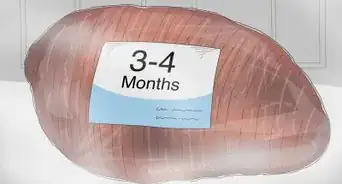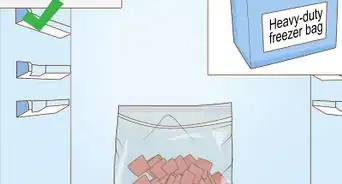This article was co-authored by Bill Holdenstern. Bill Holdenstern is a Baker and the Co-Owner of East Bay Pie Co. in San Francisco, California. With over 10 years of experience in the food industry, he specializes in making pot pies filled with flavors from around the world. Bill trained with chefs in multiple restaurants and studied business at Bunker Hill Community College. East Bay Pie Co has been profiled in The Manual, Purple List, and Nosh.
There are 11 references cited in this article, which can be found at the bottom of the page.
wikiHow marks an article as reader-approved once it receives enough positive feedback. In this case, 92% of readers who voted found the article helpful, earning it our reader-approved status.
This article has been viewed 285,592 times.
You can ship perishable items at your own risk if they are properly packaged, abide by regulations, and can be delivered in a reasonable time limit so as not to deteriorate.[1] Items are perishable if environmental conditions (like humidity or extreme temperatures) can cause a decrease in value, pose a health hazard, or create a bad odor, nuisance, or disturbance under normal shipping and storage conditions for longer than seven calendar days. For example, dairy, seafood, meat, plants, live fish, vegetables and fruit are all perishable items.[2] When you need to ship perishable items, it's important for everyone’s safety to make sure that they'll arrive in good shape.
Steps
Planning Ahead
-
1Ensure you can send the item. Check with your carrier first about fragile, potentially hazardous, and international shipments. The destination country you’re shipping to may have restrictions you should know about so that your package is accepted. Check the Individual Country Listings of the International Mail Manual for rules regarding the country you’re sending to.[3]
- Things that can decompose easily or can’t be reasonably expected to arrive at their destination without spoiling can’t be mailed internationally. For example, fresh vegetables, fruit, meat and other items.[4]
- Dry ice cannot be sent via international mail.[5]
- You may be able to use a carrier who offers temperature controlled freight services, depending on what your sending. Consult with carriers about your individual situation.
-
2Be informed about homemade canned or jarred foods. If you are sending homemade canned or jarred foods, you should check with the National Center for Home Food Preservation for information on which foods are considered unsafe for canning and are not recommended as gifts. Home-processed cheese and meat shouldn’t be mailed, as the moisture and acidity are unknown and can cause harmful bacteria.Advertisement
-
3Tell the recipient first. If possible, notify the recipient first and schedule a delivery date that works for both of you. If the item is food that should arrive cold, tell them to ensure that it is still refrigerator cold when they open the package. Notify the recipient that they should refrigerate or freeze the food immediately. Your carrier is responsible to deliver the perishable items on time, but the customer is responsible for someone being available to receive the package.[7]
- If the item is food that should arrive cold, tell the recipient not to eat or even taste it if the following condition isn’t met: the food should be delivered partially or fully frozen, or at least refrigerator cold. If unsure, the recipient can use a food thermometer to check: it should not be above 40°F (4.4°C).[8]
-
4Consider how to send the parcel. The FDA recommends that you ship perishable items using overnight delivery.[9] Avoid sending at the end of the week. Your perishable items will probably sit in a shipping facility over the weekend. Send items as early in the week as possible.[10] Consider where the recipient is and whether they can receive food and refrigerate it on acceptance. Will their residence or place of work be better for this?
- If you’re sending items to an office, make sure that it will arrive on a weekday. Also ensure that the office has refrigerator space for keeping the items cold.
Packing Cold Items
-
1Try to avoid items that require refrigeration. If you’re shipping perishable items, try if possible to opt for items that don’t need to be kept cold. It is a lot less hassle and will require less packaging and handling considerations.
- For example, seasoning packets, hardy candy, dried fruits, and canned nuts don't require refrigeration. Homemade sweets like praline, toffee and sugar cookies don't need refrigerated packaging because their sugar content wards off bacteria.[11]
-
2Pack cold food. Don’t pack food while it’s still hot, or it will form condensation which encourages mold growth and may cause the food to become soggy. Cool the food first until it is refrigerator cold or frozen solid.[12] Then pack it in sealed plastic bags. If the food needs to stay cool or cold, include a source of cold, such as dry ice or frozen gel packs. You may want to consult with a packaging expert for your delivery service and ask which method is best for your shipment as well as where to purchase those items.[13]
- Clearly mark the package “Perishable – Keep Refrigerated” on the outside. The marking should be on the address side of the mailpiece.[14]
-
3Add gel ice packs. Choose gel ice packs for products that should be cooled at 32° F (0° C) and 60° F (16° C). Freeze them according to the manufacturer’s instructions. Put perishable food in sealed plastic bags. Separate the gel packs from the perishable items using cardboard. Alternatively, you can look for a carrier with a cold shipping program.[15]
- For example, FedEx offers cold shipping for healthcare products like medications and breast milk.
- You can use other kinds of ice packs, but disposable ice packs are the most economic choice. Test the number and size of ice packs your product needs inside the specific container you select.
-
4Add dry ice. Use dry ice for frozen items.[16] Be sure it's legal to send the frozen packaging materials in your area. Dry ice maintains its coldness longer than gel packs, but requires extra safety measures. Wear gloves and goggles when handling it so that you don’t burn yourself. Don’t let dry ice come in contact with food. Put food in a sealed plastic bag to protect it from dry ice. Separate dry ice from your perishable items using cardboard.
- Don’t wrap dry ice. Warn the recipient if the packaging contains dry ice. Check with your shipping carrier first and find out the allowable amount of dry ice.
- If you use dry ice, you need to label the address side of the box that it contains dry ice. You will also need to comply with the rules of your carrier UPS, FedEx, or USPS).
-
5Add liner. Pack the perishable item, cardboard, and coolant in a two-millimeter liner bag. Secure the bag closed with a rubber band. Now the items are ready to be placed in an insulated container.[17]
- You can purchasing shipping liner bags online or at local office supply stores.
Boxing Up Perishables
-
1Find a suitable container. The items should be placed inside a sturdy, strong box or an insulated cooler.[18] Corrugated cardboard works well.[19] Other containers you may consider are Styrofoam boxes inside of cardboard boxes, insulated liners with bubble wrap, or insulated pads.
- The box should have a Mullen Test of 200 pounds or more to use it for shipping perishable items. A Mullen Test measures how much weight boxes can handle without bursting.
- For items that need to remain cold, use insulated foam containers with walls a minimum of one and a half inches thick. Then place the foam container inside a sturdy container.[20]
-
2Include instructions. Consider including instructions for the recipient inside the package. Provide information about storage and preparation. This is optional but helpful, especially if you’re sending perishable food to customers who may be unsure how to prepare or handle it. Label any food inside the box as well as externally.
- For food items, make it clear what ingredients are included for the sake of those with allergies or dietary restrictions.
- If the item should arrive cold, include instructions about ensuring refrigerator coldness (not over 40°F/4.4°C) when they open the package. Notify the recipient that they should refrigerate or freeze the food immediately, and specify that they should not eat or even taste it if it doesn’t arrive cold.[21]
-
3Pack baked goods. Maintain the freshness of baked goods during transit by wrapping them. Use foil or plastic to wrap. Cookies and bars need individual wrapping. Pack in layers using wax paper to separate the layers. Place items stacked or in a tin.[22]
- Hard cookies ship better than soft cookies, which can break and crumble during mailing.
-
4Provide the right internal packaging. Provide at least two inches of cushion around glass and other fragile items. Make sure that bottles and jars are sealed well. Don’t choose newspaper as your packing material, as it doesn’t have cushioning. Add any buffering packing materials needed. Use items such as plastic containers and Styrofoam peanuts. Wrap items well in plastic wrap or foil and pack them snugly.[23]
- For chilled or frozen foods, opt for plastic foam peanuts, bubble wrap, bagged foam or Instapak®.
-
5Seal up the box. Use plenty of tape to keep the box from opening up during transportation. Avoid duct tape and masking tape; they can detach in cold weather and melt under hot conditions. Choose a tape meant for shipping.[24]
-
6Label the box. Address the box with a complete mailing address and phone number. Clearly mark the package “Perishable” on the outside.[25] The marking would be on the address side of the mailpiece. Also include your name and return address.[26]
- If required, contents should be identified on the address side of the mail.
- You can use a mailer endorsement if you want to request return, forwarding, or address correction for items that are undeliverable to the address specified.
- Add the instructions “Fragile, handle with care” on the address side of the mailing piece. If the contents are food, add “Food contents.”
Warnings
- Don’t send anything that needs refrigeration without refrigerated shipping. The end result will be fairly unpleasant for the receiver, as well as being potentially dangerous to their health if they try to eat something that they don't realize should be refrigerated.⧼thumbs_response⧽
- Make sure that you follow the rules of all federal agencies which may apply to the contents of your package.⧼thumbs_response⧽
- If an FDA employee deems that the contents of your package poses the threat of death or serious adverse health consequences to people or animals, they can detain the package for up to 30 days.⧼thumbs_response⧽
- Don’t use brown paper packages tied with string to wrap shipping boxes. The paper can tear, and strings can get caught in sorting belts. Your delivery service may not even accept the package.[28]⧼thumbs_response⧽
- Never ship or eat canned food if the unopened can appears swollen or damaged.[29]⧼thumbs_response⧽
Things You'll Need
Preparing Cold Items
- Foil or plastic wrap
- Dry ice or frozen gel packs
- Marker
- Safety gloves
- Goggles
- Sealable plastic bags
- Cardboard
- Liner bag
- Rubber band
Boxing Up Perishables
- Foil or plastic wrap
- Wax paper
- Cookie tin
- Strong cardboard box and/or insulated cooler
- Copy paper
- Pen or printer
- Marker
- Plastic containers
- Plastic wrap
- Foil
- Plastic foam peanuts
- Bubble wrap
- Bagged foam
- Instapak
- Shipping tape
- Labels
References
- ↑ http://pe.usps.com/text/pub52/pub52c5_001.htm
- ↑ http://www.fedex.com/us/perishables/
- ↑ https://compass.ups.com/food-packaging-tips-for-holiday-shipping/
- ↑ http://pe.usps.com/text/pub52/pub52c6_017.htm
- ↑ http://pe.usps.com/text/imm/immc1_015.htm
- ↑ http://www.clemson.edu/extension/hgic/food/food_safety/handling/hgic3605.html
- ↑ http://www.fda.gov/food/foodborneillnesscontaminants/peopleatrisk/ucm083744.htm
- ↑ http://www.clemson.edu/extension/hgic/food/food_safety/handling/hgic3605.html
- ↑ http://www.fda.gov/food/foodborneillnesscontaminants/peopleatrisk/ucm083744.htm
- ↑ https://compass.ups.com/food-packaging-tips-for-holiday-shipping/
- ↑ http://www.eatright.org/resource/homefoodsafety/safety-tips/holidays/how-to-safely-mail-homemade-food-gifts
- ↑ http://www.fda.gov/food/foodborneillnesscontaminants/peopleatrisk/ucm083744.htm
- ↑ https://compass.ups.com/food-packaging-tips-for-holiday-shipping/
- ↑ http://www.fda.gov/food/foodborneillnesscontaminants/peopleatrisk/ucm083744.htm
- ↑ http://images.fedex.com/us/services/pdf/packaging/Perishables_fxcom.pdf
- ↑ http://images.fedex.com/us/services/pdf/packaging/Perishables_fxcom.pdf
- ↑ http://images.fedex.com/us/services/pdf/packaging/Perishables_fxcom.pdf
- ↑ http://www.fda.gov/food/foodborneillnesscontaminants/peopleatrisk/ucm083744.htm
- ↑ https://compass.ups.com/food-packaging-tips-for-holiday-shipping/
- ↑ http://images.fedex.com/us/services/pdf/packaging/Perishables_fxcom.pdf
- ↑ http://www.clemson.edu/extension/hgic/food/food_safety/handling/hgic3605.html
- ↑ https://compass.ups.com/food-packaging-tips-for-holiday-shipping/
- ↑ https://compass.ups.com/food-packaging-tips-for-holiday-shipping/
- ↑ https://compass.ups.com/food-packaging-tips-for-holiday-shipping/
- ↑ http://www.fda.gov/food/foodborneillnesscontaminants/peopleatrisk/ucm083744.htm
- ↑ http://pe.usps.com/text/pub52/pub52c2_007.htm
- ↑ http://www.fda.gov/food/foodborneillnesscontaminants/peopleatrisk/ucm083744.htm
- ↑ https://compass.ups.com/food-packaging-tips-for-holiday-shipping/
- ↑ http://www.eatright.org/resource/homefoodsafety/safety-tips/holidays/how-to-safely-mail-homemade-food-gifts
About This Article
To ship perishable food, start by putting the food in sealed containers and packing them in an insulated box inside a liner bag. Then, add frozen ice packs to the package to keep items cold. Alternatively, you can use dry ice, but make sure to check with your mail carrier for their rules about using dry ice, such as the amount you can use and how to label the box. Once the box is packed, close the liner bag with a rubber band and tape up the box. Next, mark the package with, “Perishable” and attach the mailing label before sending it off with your carrier. For more advice, including how package baked goods for shipping, read on.




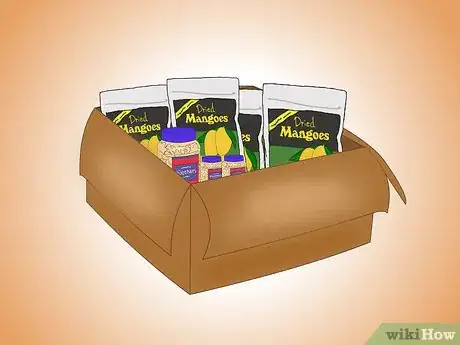



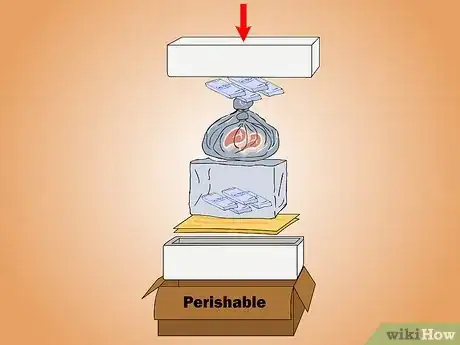

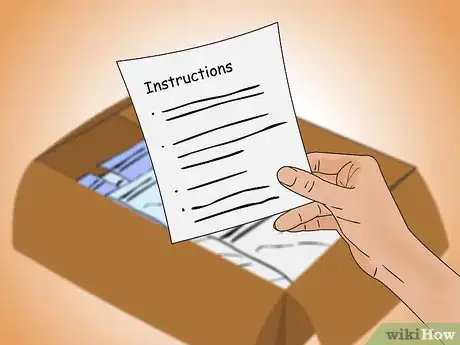

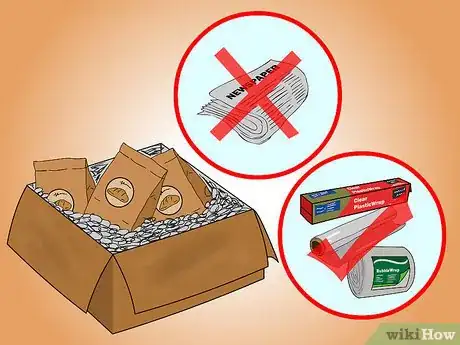








-Step-11.webp)
